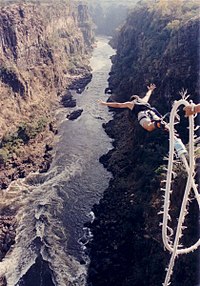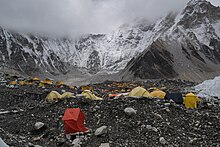

Extreme tourism, also often referred to as danger tourism or shock tourism (although these concepts do not appear strictly similar) is a niche in the tourism industry involving travel to dangerous places ( mountains, jungles, deserts, caves, canyons, etc.) or participation in dangerous events. Extreme tourism overlaps with extreme sport. The two share the main attraction, " adrenaline rush" caused by an element of risk, [1] and differ mostly in the degree of engagement and professionalism.
Well-known extreme tourist destinations include:
- Chernobyl tours – Ukraine [2] [3]
- Swimming in the Devil's Pool in Victoria Falls – Zambia and Zimbabwe [4] [5]
- Hiking the Chang Kong Cliff Road on Mount Hua – China [4] [5]
- Yungas Road tours – Bolivia [4]
- Green Zone – Baghdad, Iraq [6]
- Sac Actun tours – Riviera Maya, Mexico [4]
- Cave of Swallows – Mexico [4]
- Pole of Cold – Oymyakon, Yakutia, Siberia
- Wreck of the Titanic – Atlantic Ocean [7]
- Mount Everest – Nepal
- North Korea
- Yemen
- Afghanistan
- Space tourism [7]
See also
- Caving, Speleology
- Exploration
- Paragliding, Bungee jumping, Skydiving, Base jumping
- Storm chasing
- Urban exploration
- Via ferrata
- War tourism
References
- ^ "Extreme Tourism". Deutsche Welle (Video). May 7, 2021. Archived from the original on May 16, 2021. Alt URL
- ^ Johnson, George (October 2014). "The Nuclear Tourist". National Geographic. Vol. 226, no. 4. pp. 122–139. ISSN 0027-9358. Archived from the original on April 13, 2021.
- ^ Brooks, Rosa (June 26, 2005). "Globetrotting Ghouls With Digital Cameras". The Los Angeles Times. p. 23 – via Newspapers.com.
- ^ a b c d e Binns, Melissa (July 13, 2019). "Extreme Tourism: 10 Of The Most Dangerous Places In The World Only The Brave Dare Visit". TheTravel. Valnet.
- ^ a b Avakian, Talia (September 21, 2015). "16 adrenaline junkie attractions to visit in your lifetime". Business Insider.
- ^ "Wish you were here? Pensioner clocks up 'extreme tourism' visits to Iraq, Afghanistan ad other trouble spots". The Daily Telegraph. March 26, 2009 – via Newspapers.com.
- ^ a b Smith-Schoenwalder, Cecelia (June 29, 2023). "Despite 'Titan' Submersible's Fatal Wreck, Extreme Tourism Among the Ultra Wealthy Isn't Going Away". U.S. News & World Report. pp. C8–C11.
External links


Extreme tourism, also often referred to as danger tourism or shock tourism (although these concepts do not appear strictly similar) is a niche in the tourism industry involving travel to dangerous places ( mountains, jungles, deserts, caves, canyons, etc.) or participation in dangerous events. Extreme tourism overlaps with extreme sport. The two share the main attraction, " adrenaline rush" caused by an element of risk, [1] and differ mostly in the degree of engagement and professionalism.
Well-known extreme tourist destinations include:
- Chernobyl tours – Ukraine [2] [3]
- Swimming in the Devil's Pool in Victoria Falls – Zambia and Zimbabwe [4] [5]
- Hiking the Chang Kong Cliff Road on Mount Hua – China [4] [5]
- Yungas Road tours – Bolivia [4]
- Green Zone – Baghdad, Iraq [6]
- Sac Actun tours – Riviera Maya, Mexico [4]
- Cave of Swallows – Mexico [4]
- Pole of Cold – Oymyakon, Yakutia, Siberia
- Wreck of the Titanic – Atlantic Ocean [7]
- Mount Everest – Nepal
- North Korea
- Yemen
- Afghanistan
- Space tourism [7]
See also
- Caving, Speleology
- Exploration
- Paragliding, Bungee jumping, Skydiving, Base jumping
- Storm chasing
- Urban exploration
- Via ferrata
- War tourism
References
- ^ "Extreme Tourism". Deutsche Welle (Video). May 7, 2021. Archived from the original on May 16, 2021. Alt URL
- ^ Johnson, George (October 2014). "The Nuclear Tourist". National Geographic. Vol. 226, no. 4. pp. 122–139. ISSN 0027-9358. Archived from the original on April 13, 2021.
- ^ Brooks, Rosa (June 26, 2005). "Globetrotting Ghouls With Digital Cameras". The Los Angeles Times. p. 23 – via Newspapers.com.
- ^ a b c d e Binns, Melissa (July 13, 2019). "Extreme Tourism: 10 Of The Most Dangerous Places In The World Only The Brave Dare Visit". TheTravel. Valnet.
- ^ a b Avakian, Talia (September 21, 2015). "16 adrenaline junkie attractions to visit in your lifetime". Business Insider.
- ^ "Wish you were here? Pensioner clocks up 'extreme tourism' visits to Iraq, Afghanistan ad other trouble spots". The Daily Telegraph. March 26, 2009 – via Newspapers.com.
- ^ a b Smith-Schoenwalder, Cecelia (June 29, 2023). "Despite 'Titan' Submersible's Fatal Wreck, Extreme Tourism Among the Ultra Wealthy Isn't Going Away". U.S. News & World Report. pp. C8–C11.